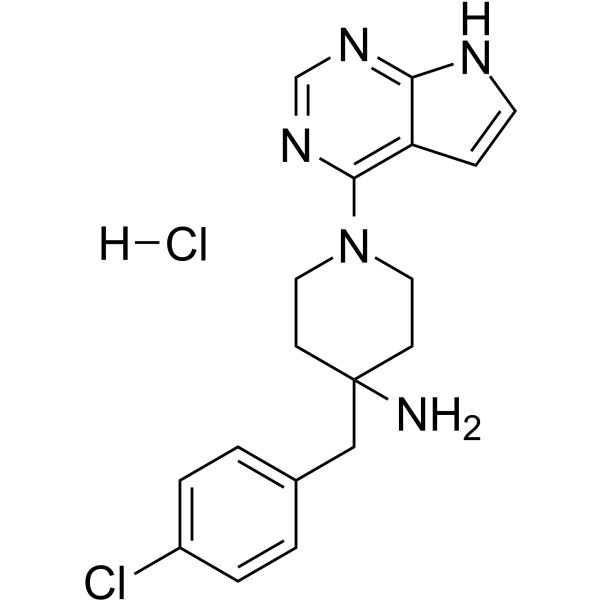Physicochemical Properties
| Molecular Formula | C18H21CL2N5 |
| Molecular Weight | 378.298841238022 |
| Exact Mass | 377.117 |
| CAS # | 2453324-32-6 |
| Related CAS # | CCT128930;885499-61-6 |
| PubChem CID | 146013807 |
| Appearance | White to yellow solid powder |
| Hydrogen Bond Donor Count | 3 |
| Hydrogen Bond Acceptor Count | 4 |
| Rotatable Bond Count | 3 |
| Heavy Atom Count | 25 |
| Complexity | 418 |
| Defined Atom Stereocenter Count | 0 |
| SMILES | ClC1C=CC(=CC=1)CC1(CCN(C2C3C=CNC=3N=CN=2)CC1)N.Cl |
| InChi Key | OFLOSUNRPFWODP-UHFFFAOYSA-N |
| InChi Code | InChI=1S/C18H20ClN5.ClH/c19-14-3-1-13(2-4-14)11-18(20)6-9-24(10-7-18)17-15-5-8-21-16(15)22-12-23-17;/h1-5,8,12H,6-7,9-11,20H2,(H,21,22,23);1H |
| Chemical Name | 4-[(4-chlorophenyl)methyl]-1-(7H-pyrrolo[2,3-d]pyrimidin-4-yl)piperidin-4-amine;hydrochloride |
| HS Tariff Code | 2934.99.9001 |
| Storage |
Powder-20°C 3 years 4°C 2 years In solvent -80°C 6 months -20°C 1 month Note: Please store this product in a sealed and protected environment, avoid exposure to moisture. |
| Shipping Condition | Room temperature (This product is stable at ambient temperature for a few days during ordinary shipping and time spent in Customs) |
Biological Activity
| Targets | Akt2 6 nM (IC50) PKA 168 nM (IC50) p70S6K 120 nM (IC50) Autophagy Apoptosis |
| ln Vitro | CCT128930 hydrochloride's growth inhibition GI50 values for PTEN-deficient human tumor cell lines are 6.3 μM for U87MG human glioblastoma cells, 0.35 μM for LNCaP human prostate cancer cells, and 1.9 μM for PC3 human prostate cancer cells[1]. AKT phosphorylation at serine 473 is first induced up to 20 μM in response to CCT128930 (0.1-60 μM; 1 hour; U87MG human glioblastoma cells) hydrochloride, and then decreases at higher concentrations[1]. With essentially constant levels of the corresponding total proteins and GAPDH, CCT128930 hydrochloride inhibits the downstream target, pSer235/236 S6RP, at ≥10 μM, and the direct substrates of AKT (Ser9 GSK3β, pThr246 PRAS40, and pT24 FOXO1/p32 FOXO3a) at ≥5 μM[1]. After half an hour, pSer473 AKT phosphorylation increases in response to CCT128930 (18.9 μM; U87MG human glioma cells) hydrochloride, and this effect lasts for 48 hours. Between 8 and 48 hours after therapy, the total AKT protein signal gradually drops[1]. In HepG2 and A549 cells, CCT128930 hydrochloride (0–10 μM; 24 hours) phosphorylates Akt more than it inhibits. By downregulating cyclin D1 and Cdc25A and upregulating p21, p27, and p53, CCT128930 (0–20 μM; 24 hours) hydrochloride prevents cell division. Hydrochloride of CCT128930 (20 μM) activates caspase-3, caspase-9, and PARP, which in turn causes cell death. HepG2 cells' phosphorylation of ERK and JNK is increased by CCT128930 hydrochloride (0–20 μM; 24 hours). HepG2 cells' DNA damage response is activated by CCT128930 (0–20 μM; 24-hour exposure), which is characterized by the phosphorylation of H2AX, ATM (ataxia-telangiectasia mutant), Chk1, and Chk2[2]. |
| ln Vivo | In U87MG and BT474 human breast cancer xenografts, CCT128930 hydrochloride (25 or 40 mg/kg; intraperitoneal daily or twice daily for 5 days) exhibits antitumor activities[1]. The pharmacokinetic parameters of CCT128930 (25 mg/kg) in CrTacNCr- Fox1nu mice are summarized as follows: Tissue Route T1/2 (h) Tmax (h) Cmax (μM) Vss (L) Cl (L/h) AUC0-∞ (μMh) Bioavailability (%) Plasma iv 0.95 0.083 6.36 0.25 0.325 4.62 100 MCE has not independently confirmed the clearance. precision of these techniques. They are merely meant to be used as references. |
| Animal Protocol |
Animal/Disease Models: 6-8 weeks old female CrTacNCr-Fox1nu (nude) mice[1] Doses: 25 mg/kg (U87MG human glioblastoma xenografts) or 40 mg/kg (BT474 human breast cancer xenografts) Route of Administration: ip daily for 5 days (U87MG human glioblastoma xenografts); ip twice (two times) daily for 5 days (BT474 human breast cancer xenografts) Experimental Results: Giving a treated:control (T/C) ratio on day 12 of 48%. There was no weight loss associated with this regime in U87MG human glioblastoma xenografts. Had a profound antitumor effect with complete growth arrest and a T/C ratio of 29% on day 22. This regimen was associated with minimal weight loss, with a nadir of only 94.8% of the initial body weight on day 15 of treatment in BT474 human breast cancer xenografts. |
| References |
[1]. Preclinical pharmacology, antitumor activity, and development of pharmacodynamic markers for the novel, potent AKT inhibitor CCT128930. Mol Cancer Ther. 2011 Feb;10(2):360-71. [2]. CCT128930 induces cell cycle arrest, DNA damage, and autophagy independent of Akt inhibition. Biochimie. 2014;103:118-125. |
Solubility Data
| Solubility (In Vitro) | DMSO : 20 mg/mL (52.87 mM) |
| Solubility (In Vivo) |
Solubility in Formulation 1: ≥ 2 mg/mL (5.29 mM) (saturation unknown) in 10% DMSO + 40% PEG300 + 5% Tween80 + 45% Saline (add these co-solvents sequentially from left to right, and one by one), clear solution. For example, if 1 mL of working solution is to be prepared, you can add 100 μL of 20.0 mg/mL clear DMSO stock solution to 400 μL PEG300 and mix evenly; then add 50 μL Tween-80 to the above solution and mix evenly; then add 450 μL normal saline to adjust the volume to 1 mL. Preparation of saline: Dissolve 0.9 g of sodium chloride in 100 mL ddH₂ O to obtain a clear solution. Solubility in Formulation 2: ≥ 2 mg/mL (5.29 mM) (saturation unknown) in 10% DMSO + 90% (20% SBE-β-CD in Saline) (add these co-solvents sequentially from left to right, and one by one), clear solution. For example, if 1 mL of working solution is to be prepared, you can add 100 μL of 20.0 mg/mL clear DMSO stock solution to 900 μL of 20% SBE-β-CD physiological saline solution and mix evenly. Preparation of 20% SBE-β-CD in Saline (4°C,1 week): Dissolve 2 g SBE-β-CD in 10 mL saline to obtain a clear solution. (Please use freshly prepared in vivo formulations for optimal results.) |
| Preparing Stock Solutions | 1 mg | 5 mg | 10 mg | |
| 1 mM | 2.6434 mL | 13.2170 mL | 26.4340 mL | |
| 5 mM | 0.5287 mL | 2.6434 mL | 5.2868 mL | |
| 10 mM | 0.2643 mL | 1.3217 mL | 2.6434 mL |
